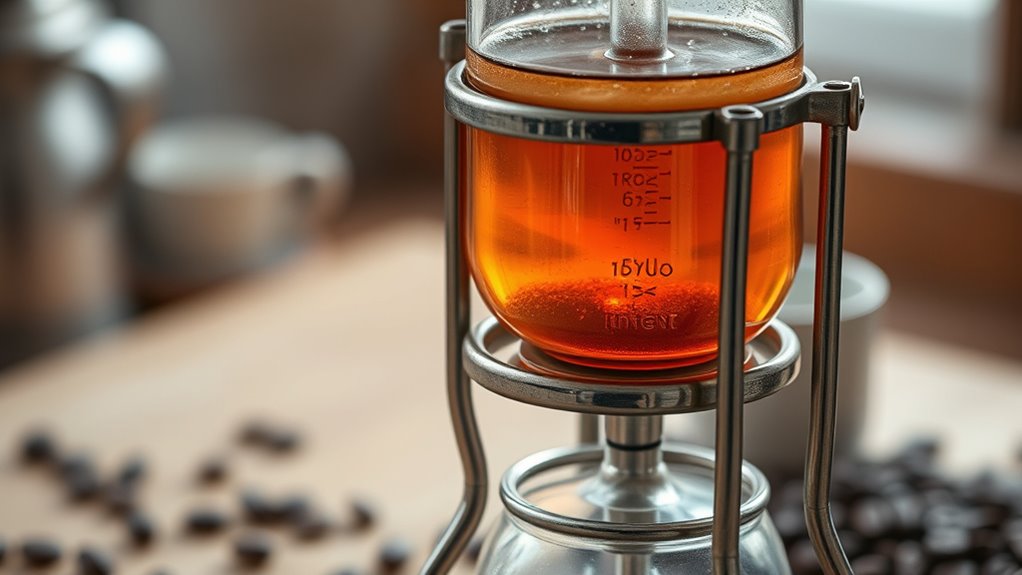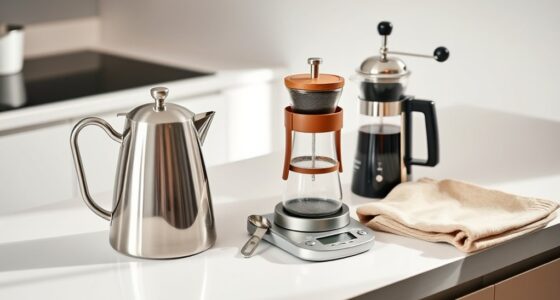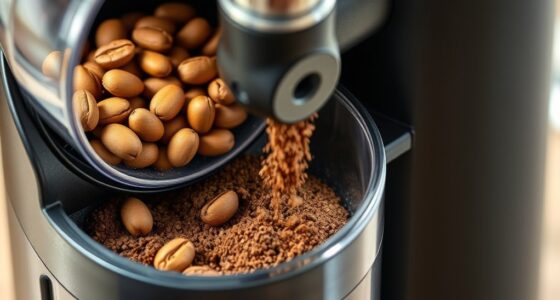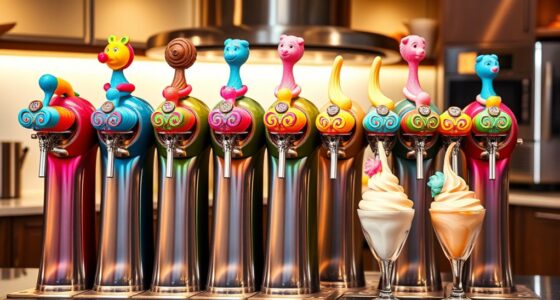Siphon coffee makers combine science and art to create a unique brewing experience. Using vapor pressure and gravity, heat causes water to rise and pass through coffee grounds, then cools to create a vacuum that pulls the brew back down, resulting in a clean, flavorful cup. Their visually engaging process appeals to both science lovers and coffee enthusiasts. Want to discover how these devices work and their fascinating history? Keep exploring to find out more.
Key Takeaways
- Siphon coffee makers operate on vacuum principles, using vapor pressure and gravity to brew and extract flavors.
- The process involves heating water, which rises into the upper chamber, then cools and is pulled back through the grounds for a clean brew.
- Materials like borosilicate glass and various filters influence brewing quality, aesthetics, and the overall art of siphon coffee.
- The visual spectacle of the brewing process emphasizes craftsmanship, blending science with artistic presentation.
- Modern automated siphon machines make the intricate and artistic brewing method accessible for everyday use and specialty coffee enthusiasts.
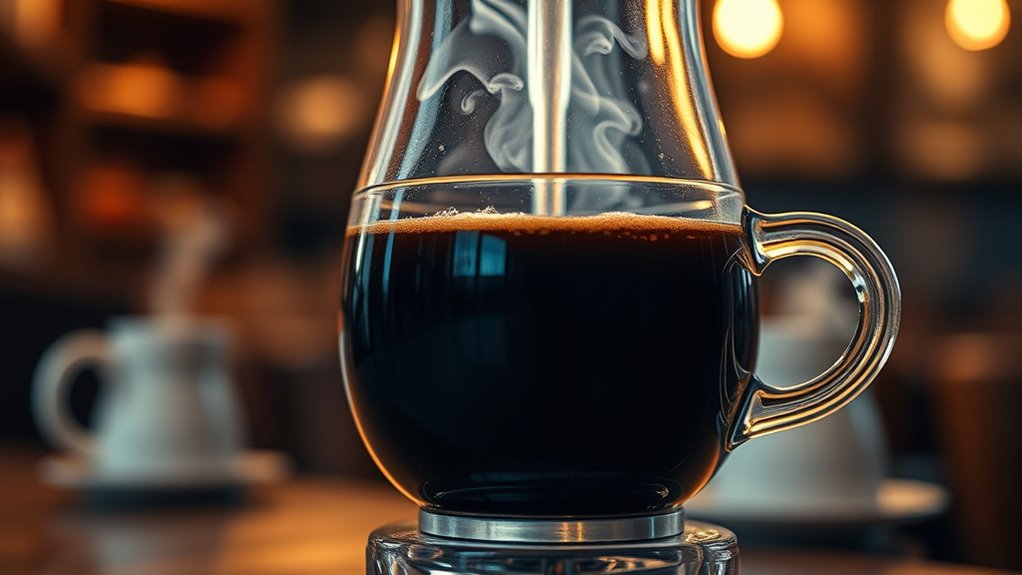
Have you ever wondered how a simple vacuum process can brew such a clean and flavorful cup of coffee? The answer lies in the fascinating science and rich history behind siphon coffee makers. This brewing method dates back to the 1830s when Loeff of Berlin filed the first patent for a siphon coffee brewer. Not long after, Mme. Vassieux successfully commercialized her design in 1840, featuring two glass vessels that became iconic. Their innovations sparked a wave of patents and improvements, reflecting the method’s popularity across Europe.
Today, the siphon coffee maker has evolved from early glass and metal designs to modern automated versions, but its core principles remain rooted in centuries of experimentation.
The science behind siphon brewing is both elegant and straightforward. It operates on the vacuum principle: as the water in the lower vessel heats up, it expands, pushing water upward into the upper chamber where the coffee grounds are. When the heat source is removed, the water cools, contracting and creating a vacuum. This vacuum pulls the brewed coffee back down through a filter into the lower vessel, leaving the grounds behind. Understanding vapor pressure helps explain why this process works so effectively.
Unlike other methods, siphon brewing doesn’t rely on high heat; instead, it harnesses vapor pressure and gravity to extract flavors delicately and thoroughly. This process results in a clean, vibrant cup with bright acidity and nuanced aroma, making it highly prized by coffee connoisseurs.
Design and materials have continuously advanced to enhance the brewing experience. Early siphon makers used borosilicate glass, metal, or plastic for the chambers, often decorated with aesthetic touches, especially in Mme. Vassieux’s early models. Filters have ranged from glass rods and metal screens to cloth, paper, and nylon.
Some innovative designs, like the balance siphon, incorporated side-by-side chambers with a counterweight system, while modern versions, such as the Siphonysta, employ electric heating for convenience. Despite variations, the core design emphasizes visual appeal and precision, allowing users to observe the brewing process and appreciate the craft involved.
Siphon coffee’s popularity surged in the 19th century, particularly in Europe, where its clear, bright brew appealed to refined tastes. It remains popular today in Japan, Taiwan, and specialty coffee shops worldwide.
While initially complex and somewhat elaborate for everyday use, modern automated models have made it accessible to enthusiasts and professionals alike. Its distinctive method and the theatrical presentation continue to attract a global following.
Whether you prefer the traditional glass setup or a sleek electric version, siphon coffee makers offer a unique blend of science and artistry, producing a cup that’s as visually engaging as it’s flavorful.
Frequently Asked Questions
Can Siphon Coffee Makers Be Used With Cold Brew?
You might wonder if siphon coffee makers can be used for cold brew. While technically possible, it’s not practical. Siphons are designed for high-temperature brewing, not cold steeping, and lack insulation for extended cold contact.
The filters and glass chambers aren’t optimized for cold extraction, risking inconsistent results. Plus, the long brew time and cleaning complexity make cold brew in a siphon inefficient compared to dedicated cold brew setups.
How Long Does a Typical Siphon Coffee Brewing Process Take?
You might think brewing takes hours, but with a siphon coffee maker, it’s surprisingly quick. The entire process usually lasts between 2 to 3 minutes, combining precise timing and technique.
You heat, steep, and draw down the coffee efficiently, enjoying a delicate, flavorful brew in just a few minutes. This quick yet immersive method highlights the artistry behind siphon brewing, making it both a visual and sensory delight.
Are Siphon Coffee Makers Suitable for High-Altitude Brewing?
You might wonder if siphon coffee makers work well at high altitudes. Since water boils at lower temperatures and pressure is reduced, brewing efficiency can decrease.
You’ll need to adjust your technique, like preheating equipment and tweaking brew times. While siphon brewers aren’t specifically designed for high-altitude conditions, with some modifications, you can still enjoy great coffee.
However, alternative methods like immersion brewing could be more reliable in such environments.
What Maintenance Is Required to Keep a Siphon Coffee Maker Functioning?
To keep your siphon coffee maker working well, you need regular maintenance. Rinse the cloth filter and chambers with hot water after brewing.
Soak the filter in hot water with Cafiza every 5 uses.
Do deep cleaning monthly with a vinegar or Cafiza solution, and disassemble parts for thorough scrubbing.
Check rubber gaskets for wear, inspect glass for cracks, and dry everything completely before storing.
Proper upkeep ensures ideal performance and longevity.
Can Siphon Coffee Makers Be Used to Brew Other Beverages?
You can definitely use siphon coffee makers to brew other beverages. By adjusting heat and steeping times, you can prepare teas, herbal infusions, yerba mate, and even botanicals.
Experiment with different filters and temperatures to get the flavors just right. Keep in mind, some adjustments are necessary for each beverage, but the siphon’s versatile mechanism makes it a fun tool for creating a variety of hot drinks.
Conclusion
Siphon coffee makers showcase the perfect blend of science and skill, transforming brewing into a beautiful, bubbling ballet. With a bit of patience and practice, you’ll master the mesmerizing motion, making each cup a crafted creation. Embrace the elegance, enjoy the artistry, and savor the sensational results. So, step into the world of siphon brewing, and let your passion pour into every passionate, pristine pot you produce. Your perfect pour is just a process away!
